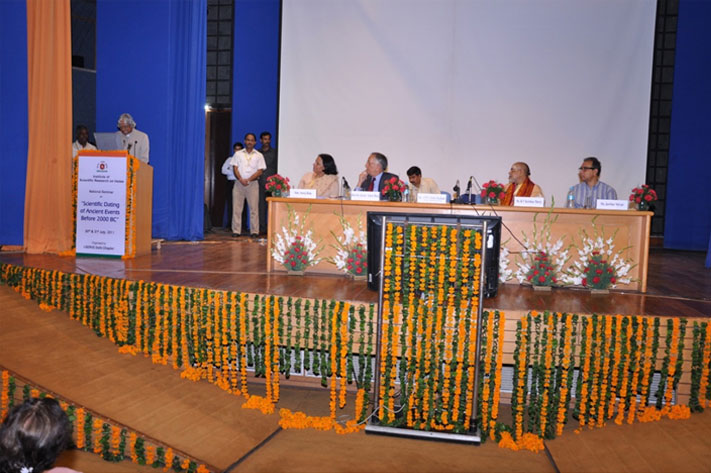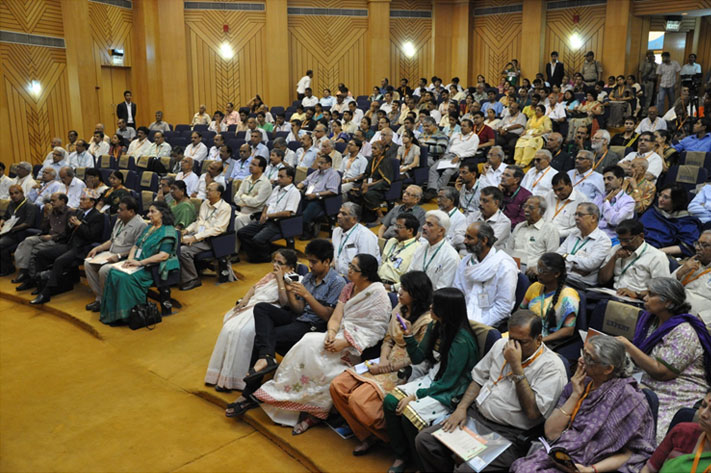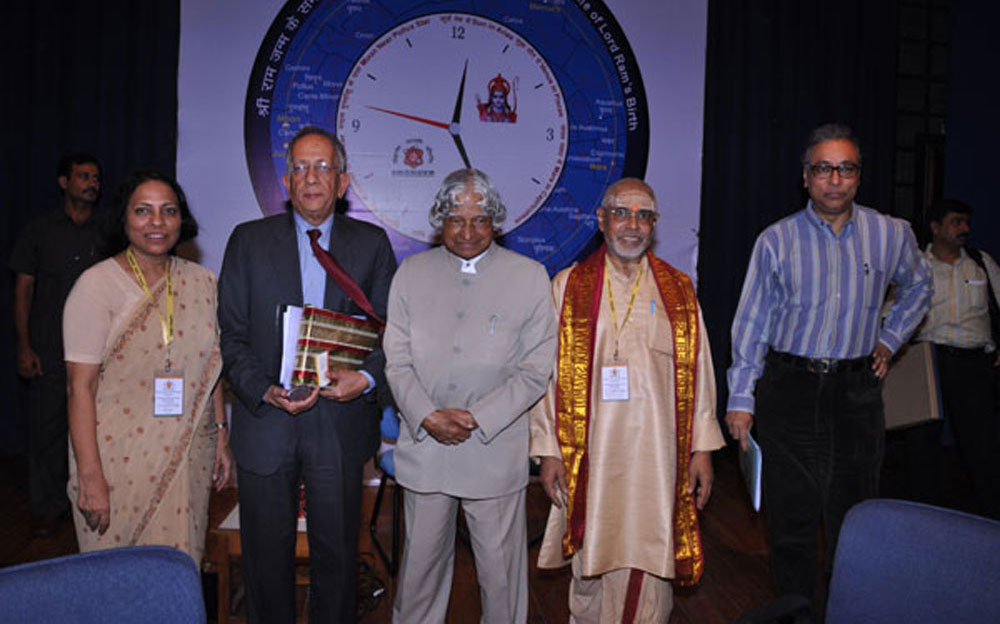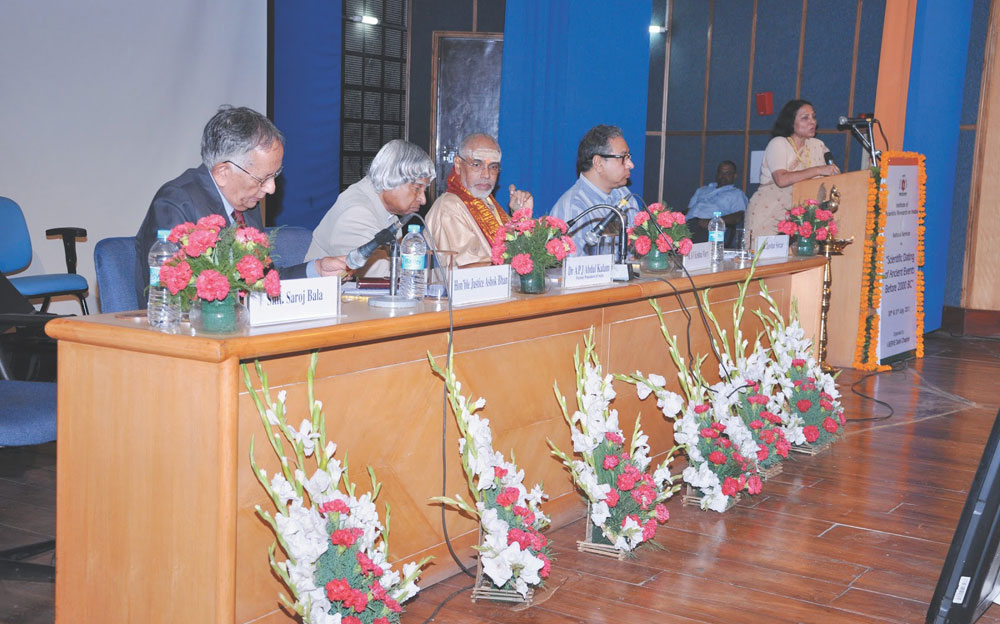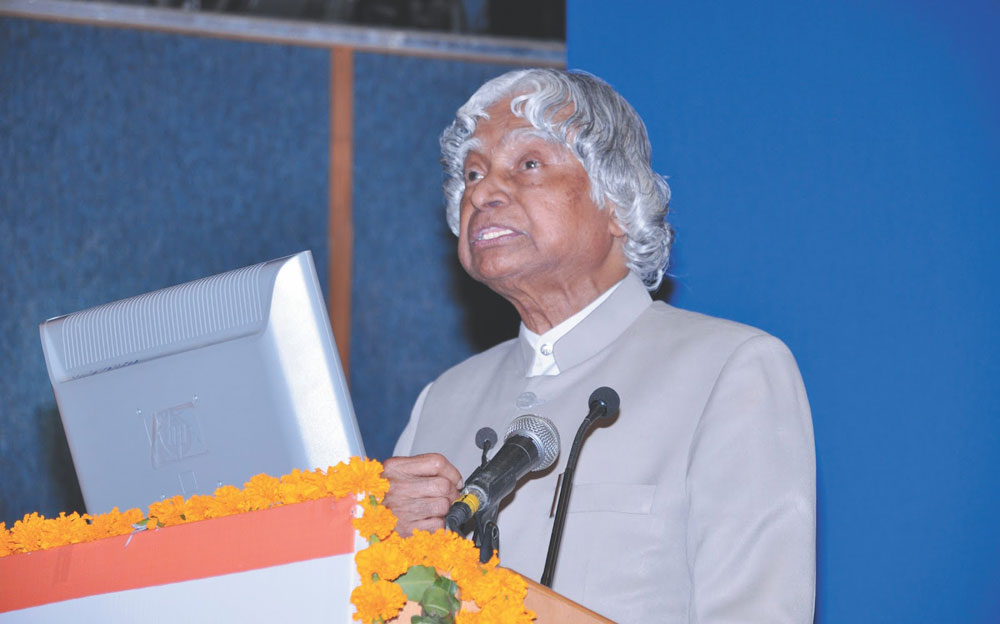Scientific Dating of Ancient Events before 2000 BC: Astronomical Dating of Planetary References in Ancient Sanskrit Manuscripts & Corroborating Archaeological, Anthropological, Oceanographic and Remote Sensing Evidences
(30-31 July 2011)
National Seminar on "Scientific Dating of Ancient Events Before 2000 BC……"
at New Delhi on 30th & 31st July, 2011
A two-day national seminar on the subject, "Scientific Dating of Ancient Events before 2000 BC" was held on 30th and 31st July 2011 in the auditorium of IIMC at Aruna Asaf Ali Marg, New JNU Campus, New Delhi. The Seminar was attended by Sanskrit scholars and astronomers, archaeologists and anthropologists, geologists and ecologists, oceanographers and space scientists, bureaucrats and professionals, professors and academicians as well as other persons from the public and media, who were interested in this subject.
His Excellency Dr. A.P.J. Abdul Kalam (Former President of India) blessed the occasion with his venerated presence as the chief guest and delivered the inaugural address on 30th July which is given hereunder.
Hon'ble Justice Sh. Ashok Bhan, Chairman of NCDRC, and Sh. J. Sircar, Secretary of Culture were the guests of Honor. Sh. K. V. Krishnamurthy, Chairman, I-SERVE delivered the welcome address and Mrs. Saroj Bala, Research Project Coordinator gave a brief introduction to the subject of the Seminar.
Overview of the Seminar followed by Inaugural Address by Dr A.P.J. Abdul Kalam (Part -1)
His Excellency Dr A.P.J. Abdul Kalam endorsed the scientific methods of dating of ancient events and emphasized that a mechanism needs to be built to disseminate the knowledge and information generated during the seminar amongst school and college children to generate a shared pride in our rich and most ancient heritage. His speech acted as a big motivating factor and as a morale booster for the research team of I-SERVE. He made many important recommendations, including launching research on the historicity of India's Epics with at least 100 PhDs and relating this scientific dating with human genome sequences. Dr Kalam asserted every Indian epic deals with human history, their conflicts, and their civilization and that we need to establish the relationship between the birth of spoken language as per Prof Tobias and the evolution of Maharshi Valmiki Ramayana.
While welcoming Dr. Kalam as Chief Guest, Saroj Bala is providing an overview of the Seminar "Scientific Dating of Ancient Events before 2000 BC: Astronomical Dating of Planetary References in Ancient Sanskrit Manuscripts & Corroborating Archaeological, Anthropological, Oceanographic and Remote Sensing Evidences", on 30th July 2011.
This video makes a case for rewriting the history of the Indian subcontinent, based purely on multi-disciplinary scientific research. The planetary references in Valmiki Ramayan could actually be seen sequentially in the sky around 5100 BCE, confirming the assertions made by Dr Kalam during the inaugural address.
Seminar Overview & Welcome of Dr. A.P.J. Abdul Kalam BY SAROJ BALA
For more information and videos on the subject visit -
https://www.youtube.com/c/RigvedatoRobotics/videos
How archaeological, paleo-botanical, oceanographic, ecological and remote sensing research reports corroborate these astronomical dates is amazing! While delivering the inaugural address Dr. A P J Abdul Kalam said, "I am happy that through such genomic studies, it has been found that Harappan civilization was not of mysterious people of unknown biological origins, or migrants from centers of high culture in western Asia, but they were descendants of population identified with pre-Harappan cultures of the North Western sector of the sub-continent.
This makes research in genetic engineering, using human genome sequences to understand the evolution of humans, very fascinating for scientists…. I am happy that through the use of modern technology, the perception of Indian Archaeology has changed and has facilitated the researchers to prove an indigenous origin of civilization in the Indian Sub-continent.
This is an important factor that should work as an integrator of the entire nation since all of us have come into this land from the same ancestors and roots. The research on scientific dating may have partners, who can provide scientific, astronomical, anthropological, geological, and genetic data to ascertain the veracity of the historical events.
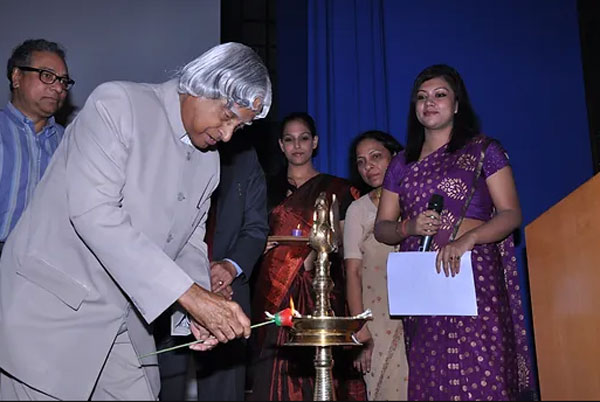
Inaugural function of the National Seminar on 'Scientific Dating of Ancient Events before 2000 BC' on 30th July 2011, New Delhi
During the first presentation made during the Seminar, the astronomical dates of planetary references in Rigveda and Ramayan, using Planetarium Gold Software, were determined. These cannot be repeated again in 25920 years; therefore, these provide almost precise dates. After that correlation with evidence from archaeological, paleo-botanical, oceanographic, ecological, genetic, and remote sensing research reports has continued to date. Two Seminars, two Conferences, and two Exhibitions have been organized so far and six books have been authored on the subject.
Valmiki packed so many proofs in Ramayan that it is not difficult to Date the events, said Dr Kalam during Inaugural Address (Part – 2)
During his inaugural address, DR Kalam clarified that the planetary references in Valmiki Ramayan could actually be seen sequentially in the sky around 5000 BCE, and later research carried out proved his assertions correct. Hear him saying that "the important aspect about the Ramayan is that when Valmiki composed the epic, he made it with many proofs. He packed so much information about the various planetary positions of those days, the geography of the areas mentioned in the epic, the seasonal events, and about the genealogy of various kings that it is virtually a no-brainer to establish the dates on which those events occurred……….
Inaugural Address by Hon'ble Dr. A P J Abdul Kalam
For more information and videos on the subject visit -
https://www.youtube.com/c/RigvedatoRobotics/videos
Astronomical calculations, making use of Planetarium software, have proved that events narrated in Valmiki Ramayana actually occurred around 7000 years back and they can be sequentially dated. Ram Setu is found submerged at the same location as is described in Valmiki Ramayan……" Dr Kalam made out a strong case for rewriting the history of the Indian Subcontinent based on multi-disciplinary scientific evidence. He believed that the history of civilization in India would get pushed back by a few millennia.
Report in Puratattva on National Seminar, "Scientific Dating of Ancient Events Before 2000 BC", New Delhi (30th & 31st July 2011)*
Institute of Scientific Research on Vedas (I-SERVE, Delhi Chapter) organized a National Seminar on "Scientific Dating of Ancient Events Before 2000 BC" on 30th – 31st July 2011 in the Indian Institute of Mass Communication auditorium, Aruna Asaf Ali Marg, New JNU Campus, New Delhi. The objective of the seminar was twofold: to ascertain astronomical dating of planetary references in ancient Sanskrit manuscripts by making use of planetarium software and correlating it with archaeological, anthropological, paleo botanical, geological, ecological, oceanographic and remote sensing evidence.
This Seminar was financially supported by Rashtriya Sanskrit Sansthan, Ministry of Human Resource Development and Ministry of Earth Sciences, Govt. of India. It was attended by scholars from the disciplines of Sanskrit, astronomy, archaeology, anthropology, history, geology, ecology, oceanography, space science, and students of various universities and academicians as well as other persons from the public and media, were invited to participate.
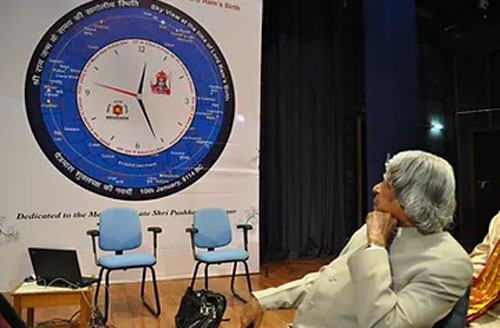
H.E. Dr. A.P.J. Abdul Kalam unveiled the Seminar Memento which depicts the sky view at the time of birth of Lord Ram on 10th January, 5114 BC
His Excellency Dr. A.P.J. Abdul Kalam (Former President of India) blessed the occasion with his venerated presence as Chief Guest and delivered the inaugural address on 30th July (The text of this address is also available at www.abdulkalam.com). Honorable Justice Shri Ashok Bhan, Chairman of the National Consumer Disputes Redressal Commission, and Shri J. Sircar, Secretary to Govt. of India (Ministry of Culture) were the Guests of Honour. Shri K.V. Krishnamurthy, Chairman of I-SERVE delivered the welcome address. Mrs. Saroj Bala, gave a brief introduction of the subject, clearly stating that astronomical, archaeological, anthropological, and ecological research reports have revealed that the Aryan invasion theory was a myth based entirely on linguistic guesswork and that indigenous civilization has been continuously developing in India for last more than 10000 years.
Dr. A.P.J. Abdul Kalam endorsed the scientific methods of dating of ancient events and emphasized that a mechanism needs to be built to disseminate the knowledge and information generated during the seminar amongst school and college children to generate a shared pride in our rich and most ancient heritage. He made many important recommendations, which include:
- Launching research on India's Epics with at least 100 Ph. Ds with highly talented historical, geological, astronomical, and space scientists to ascertain the veracity of history and dates of events in our epics.
- The scientific dating of our epics has also to be related to genealogy and with human genome sequences.
- The origin and human evolution put forwarded by Prof. Tobias should be related to the events of Indian epics.
- The spoken language period as per Prof. Tobias is around 10000 years old and the birth of Rama is based on the 9th tithi of Chaitra month and sky view of planetary configurations at the time of birth dates to 10th January in 5114 BC, that is 7125 years back. We need to establish the relationship between the birth of spoken language and the evolution of Valmiki Ramayana.
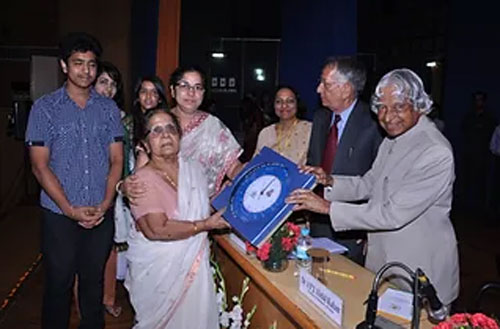
H.E. Dr. A.P.J. Abdul Kalam presenting the Seminar Memento to Smt. Pushpa Bhatnagar, mother of Late Shri Pushkar Bhatnagar, author of the book 'Dating the Era of Lord 'Ram'.
The highlight of the seminar was the release of the Seminar Memento, a Wall Clock depicting the sky view on 10th January, 5114 BC at 12:25 PM, which also happened to be the shukla paksha Navami of Chaitra month i.e. the date of birth of Lord Rama. This sky view matched exactly the planetary configurations given in Valmiki Ramayan (1/18/8, 9). The Memento was dedicated to the memory of Late Shri Pushkar Bhatnagar, the original investigator. It was released by Dr. A.P.J. Abdul Kalam.
Address by Shri Ashok Bhatnagar
The first speaker, Shri Ashok Bhatnagar, Former Additional DG. India Meteorological Department, presented a paper on "Astronomical Dating of Planetary References in Rigveda and Epics using Planetarium Software." He stated that astronomical references in Rigveda represent the sky views of dates belonging to the period from 8000 BC to 4000 BC and those mentioned in Ramayana refer to sky views seen sequentially on dates around 5000 BC. He gave a live presentation on planetarium software and generated pictures of sky view depicting planetary configurations narrated in Valmiki Ramayan. The sky view at the birth of Lord Ram was seen on 10th January 5114 BC and sky views on several dates right from the start of Putra Kameshthi Yajna (15th January, 5115 BC) to the start of a journey to Lanka (Uttara Phalguni Nakshtra on 19 Sept, 5076 BC) matched exactly the descriptions in Ramayan. This presentation established in an extremely scientific manner that many of the events mentioned in Vedas and Epics are real and these reflect the continuous and indigenous development of civilization in India for the last 10000 years.
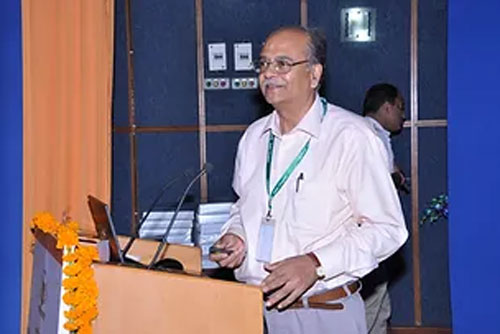
Shri Ashok Bhatnagar
Address by Shri Kulbhushan Mishra
Shri Kulbhushan Mishra (Indian Archaeological Society, New Delhi) spoke on the "Origin and Development of Civilization in Indian Subcontinent during last 8000 years: An Archaeological Perspective" and informed that the latest archaeological excavations have revealed a large volume of new data which has proved an indigenous origin and development of civilization in the Indian Subcontinent since 7000 BC. In this regard, Shri Mishra cited some examples such as Mehrgarh, Kot Diji and Nausharo in Indus Valley in the northwest; Lothal and Dholavira in the west and Lahuradeva, Jhusi, Tokwa and Hetapatti in Ganga Valley in the east. The material testimonies of these excavations have shown gradual cultural developments from the 7th -6th millennium BC in the entire region of the Indus-Saraswati-Ganga system for a period of almost eight thousand years. Thus archaeology also supports the astronomical, ecological and anthropological conclusions that Aryans were originals of India.
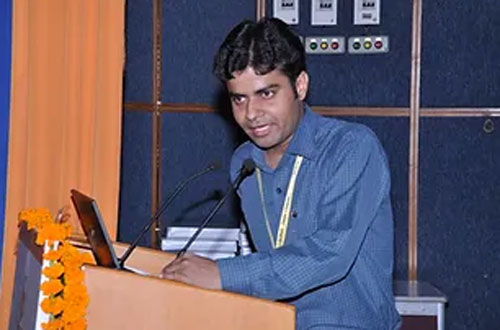
Shri Kulbhushan Mishra
Address by Dr. C.M. Nautiyal
Dr C.M. Nautiyal (Scientist-in-charge of the Radiocarbon Dating Laboratory at Birbal Sahni Institute of Palaeobotany, Lucknow) spoke on the “Radiometric Dating of Records of Ancient Cultures in India”. He explained in detail the theoretical basis, principles and methods of radiometric dating techniques. To understand the origin and development of any civilization, time is among the most important parameters. Some new methods, e.g., Thermo-Luminescence, Optically Stimulated Luminescence (OSL) and Accelerator Mass Spectrometry (AMS) have also been developed.
By making use of such methods, many Indian laboratories, such as the Physical Research Laboratory (Ahmadabad) and Birbal Sahni Institute of Palaeobotany (Lucknow) have ascertained the dates of thousands of archaeological samples. This has played a very crucial role in understanding the origin and development of civilization in India during the last more than 8000 years. He also gave some interesting examples like the dates for samples of rice and wheat from Lahuradeva and Jhusi have been found to be about 7000 years old.
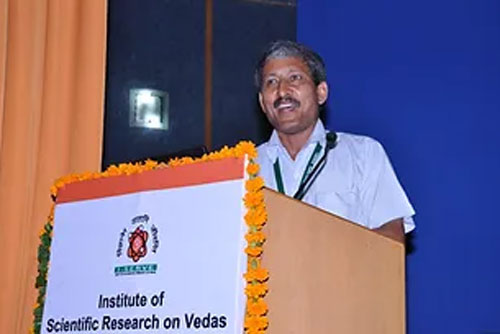
Dr. C.M. Nautiyal
Address by Dr. Chanchala Srivastava
Dr Chanchala Srivastava (Scientist-in-charge of the Archaeobotany Unit at Birbal Sahni Institute of Palaeobotany, Lucknow) spoke on “Archaeobotanical Evidences of Ancient Cultures in Indian Subcontinent”. She explained at length the archaeobotanical research reports which have revealed that certain cultivated varieties of plants, trees and herbs, which are mentioned in Vedas and epics, have existed in India continuously for more than 8000- 9000 years.
She further elucidated that the remains of cultivated rice, wheat and barley have been found belonging to 7000 BC in Mehrgarh of the Indus Region and Lahuradeva of Middle Ganga Plains. The remains of dwarf-wheat, bread-wheat, barley, lentil and field pea have also been reported from Lahuradeva and the earlier phases of Neolithic deposits at Gufkral and Burzahom. The melon seeds, lemon leaf, pomegranate, coconut, date palm etc related to 4000 BC have been found in several Harappan sites of Haryana. She emphasized that there was no abrupt end of ancient Indian civilization as is normally being taught in schools and colleges.

Dr. Chanchala Srivastava
Address by Dr. J.R. Sharma
On 31st July, Dr. J.R. Sharma (Regional Remote Sensing Centre, Jodhpur) was the first to present his paper on "Signatures of Paleo-Rivers and their Networks in North Western India: Inputs from Remote Sensing". He elaborated that the remote sensing images taken by the Indian Space Research Organisation, corroborated by geological reports, have revealed that a mighty river system referred to in Vedas and Epics as Saraswati was in full glory around 6000 BC. The river slowly dried up and almost disappeared around 2000 BC. He highlighted that these conclusions have been drawn by sedimentology, hydrogeology and drilling data and also support the astronomical dates of Vedas and Epics.
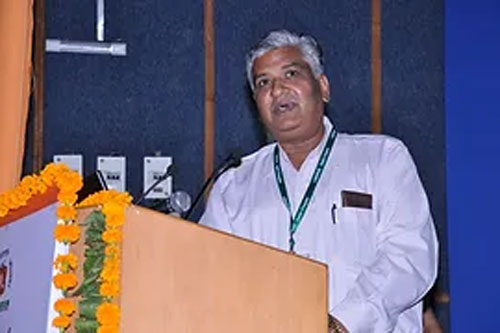
Dr. J.R. Sharma
Address by Dr. Rajiv Nigam
The next paper was by Dr. Rajiv Nigam (National Institute of Oceanography, Goa), on "Sea level Fluctuations during last 15000 thousand years and their Impact on Human Settlements". He informed about the oceanographic reports on fluctuations of water levels in the oceans which have revealed the existence of many coastal archaeological sites, either submerged or now found landlocked, dated from 7500 BC onwards, e.g., Hazira, Dholavira, Juni Kuran, Surkotda, Prabhas Patan and Dwarka, etc. These supported the historicity and dating of many events mentioned in our Epics.
Through a Sea Water Level Curve, depicting the sea levels for the last 15000 years, Dr Nigam explained that 7000 years back the sea-water level was 3 meters below the current level. This supports the astronomical dates of the Ramayan references and proves that Ramsetu was at a walkable level 7000 years back.
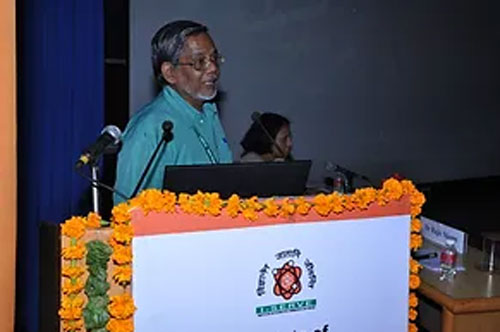
Dr. Rajiv Nigam
Address by Prof. V.R. Rao
Prof. V.R. Rao (Department of Anthropology, Delhi University), presented a paper on "Genetic Profile of the People of India during Holocene: Some Inferences" and elaborated the anthropological researches which have established that DNA dating for Paleolithic continuity starts from 60000 BC. The genome studies during the Holocene have revealed that the genetic profile of humans settled in north, south, east and west of India is the same and has remained the same for the last 11000 years.
Dr. Baldevanand Sagar (Sanskrit Scholar), spoke on "Geographic Evidence of Places and Rivers referred to in Rig Veda and Epics", discussed about the geographical region of Vedic and later Vedic period. He also highlighted the importance and existence of the river Saraswati for several millennia by citing examples from ancient texts.
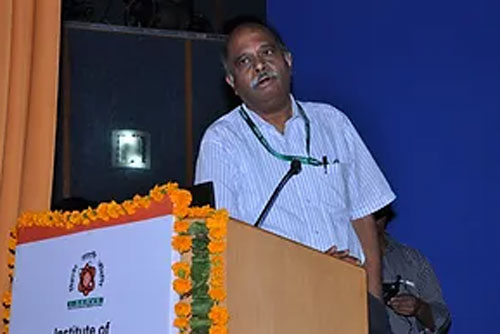
Prof. V.R. Rao
The Presentations and deliberations were continued on the next date.
Shri Pawan Kumar Bansal, Hon'ble Minister, Ministry of Parliamentary Affairs and Water Resources, was the Chief Guest for the proceedings of the Seminar on 31st July 2011. He delivered the valedictory address and appreciated the initiative of scientific determination of the dates of ancient events. Hon'ble Justice Shri Ashok Bhan, Shri Manbir Singh, Secretary, Ministry of External Affairs and Smt. Poonam Kishore Saxena, Member, Central Board of Direct Taxes, graced the occasion as the Distinguished Guests of Honour and provided some very valuable inputs during their addresses. Smt. Saroj Bala presented a summary of the proceedings.
Known worldwide for their knowledge of respective subjects, these scientists claimed that civilization and culture have been constantly developing in India for the last ten thousand years and it is possible to scientifically determine the exact dates of events of the remote past. Most of the presentations clearly pointed towards the indigenous development of civilization during the last more than 8,000 years and the continuity of culture through all these years. Vedas represented the compilation of knowledge whereas Epics reflected the corresponding historical events of ancient India.
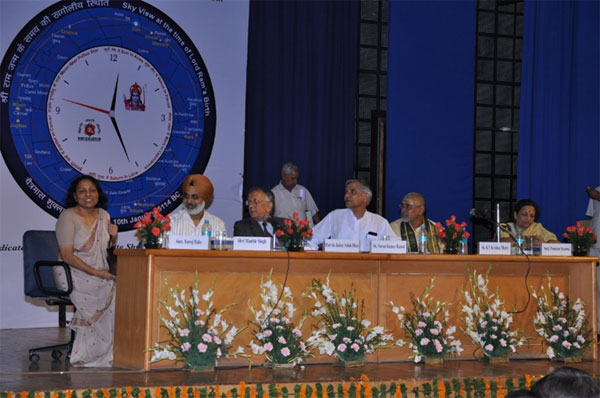
Summary of the valedictory address delivered by Shri Pawan Kumar Bansal, Hon'ble Minister, Ministry of Parliamentary Affairs and Ministry of Water Resources on 31st July, 2011:
Hon'ble Cabinet Minister Shri Pawan Kumar Bansal appreciated the initiative taken by I-SERVE and expressed his curiosity for knowing more details of the outcomes of the research on the scientific dating of ancient events. Referring to the inaugural address, he said that Dr A.P.J. Abdul Kalam has spent his lifetime inculcating the scientific temperament amongst the people of India, therefore, appreciation by him of the scientific dating of the ancient events undertaken by I-SERVE is a matter of great pride not only for I-SERVE but for all of us.
While referring to the multi-disciplinary scientific research papers presented during the Seminar, he recollected his earlier visit to the Birbal Sahni Institute of Palaeobotany, Lucknow, where scientists had explained that a large variety of cultivated herbs, referred to in our ancient manuscripts, have been found in existence in India for thousands and thousands of years. As a Minister for science and technology, he was also informed about the creation of a Digital Library of Traditional Knowledge listing more than two lakhs of medicinal formulations existing in ancient India. He felt happy that such research is being discussed in the context of the scientific dating of ancient events.
The unveiling of the clock depicting the sky view on 10th January, 5114 BC, i.e., at the time of birth of Lord Ram exactly matching the planetary configurations described in Valmiki Ramayan impressed Shri Pawan Bansal the most as it indicated that Ramayan was not merely a mythological story but was probably rooted in reality. Such evidence proving the antiquity of our civilization does promote a sense of shared national pride amongst all of us.
The Hon'ble Minister referred to the presentation on genetic profiling which had revealed that the genetic profile of north Indians as well as of Dravidians is the same and has remained the same for more than 10,000 years, revealing that they had common ancestors who were all indigenous people. Therefore, the existing divisions are man-made and are not based on reality. In order to promote unity, there is a need to disseminate such knowledge and information among all Indians, especially among schoolchildren and college students.
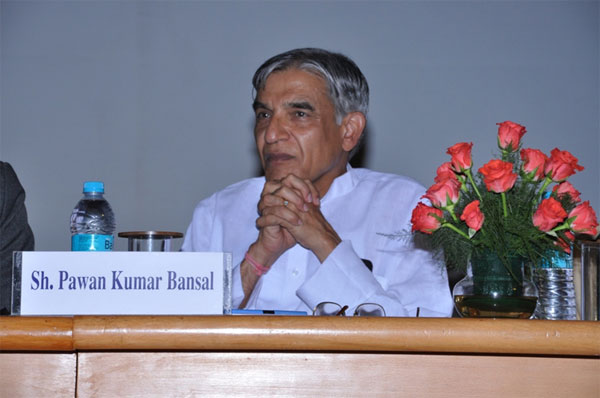
Referring to the Remote Sensing imagery of dry paleochannels of the ancient Sarasvati River and other corroborating evidence discussed during the Seminar, he stated that such studies can help in exploring the sources of much-needed potable water in these days of water scarcity when India has 16% of the world population and only 4% of world's water resources. He desired that such information should be shared by I-SERVE with the government agencies concerned so that it is used for the benefit of our countrymen.
He expressed satisfaction at some kind of synergy developing between those who have been studying Vedas and those who could make use of the information contained therein for the benefit of mankind. He complimented I-SERVE for taking the initiative to dispel the darkness and spread the light of awareness!
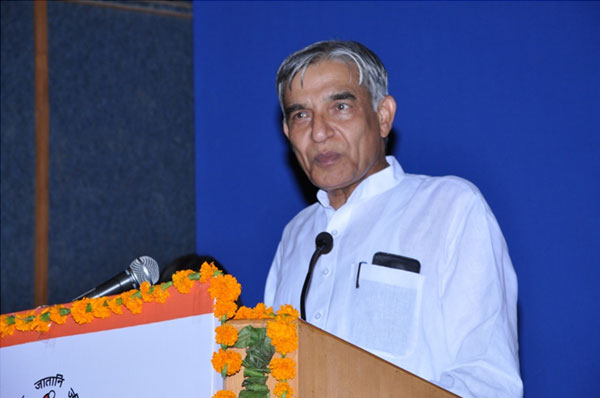
Addresses by Hon'ble Justice Ashok Bhan, Chairman, National Consumer Disputes Redressal Commission on 30th and 31st July, 2011
On 30th July, during inaugural ceremonies, Hon'ble Justice Ashok Bhan said that he was deeply interested in the research project named 'Scientific Dating of Ancient Events' taken up by Delhi Chapter of the Institute of Scientific Research on Vedas. It was interesting to learn that multidisciplinary scientific research reports have revealed that India had a thriving civilization more than 10,000 years back and that this civilization was developing indigenously, unsettling our long-standing belief that Aryans came from Central Asia to civilize us in 1500 BC.
He went on to add that the major objectives of I-SERVE which was set up in the year 2004 under the patronage of our late Dr R. Venkataraman, former President of India are: (i) establishing synergy between the scientific wisdom of ancient India and modern scientific inventions and (ii) determining historicity and dating of ancient events by making use of modern scientific tools are laudable. This Seminar organized by the I-SERVE Delhi Chapter in the pursuit of the second objective also aims at bridging the gap between the outcomes of scientific research reports on one hand and the contents of school and college books on the other.
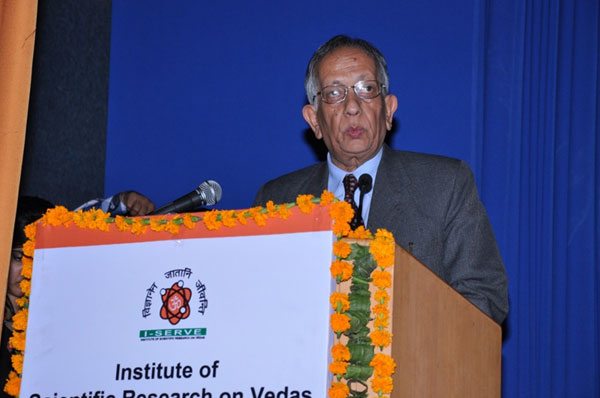
In his address during the valedictory Session on 31st July 2011, Hon'ble Justice Ashok Bhan complimented the I-SERVE Research team for doing a commendable job in attempting to determine the historicity and authenticity of ancient events by making use of scientific evidence and tools that not only push back the antiquity of our civilization but also generate a sense of shared pride in our glorious past. This is being done not by relying on any linguistic guesswork or religious beliefs but by compiling credible and convincing evidence that proves that the Indian Subcontinent had a thriving civilization more than 10,000 years ago. During his inaugural address, Dr Kalam expressed the belief that such scientific dating of ancient events has the potential of transforming mythology into history and we shall also be able to benefit from the tremendous scientific knowledge, particularly of mathematics and astronomy, contained in our ancient texts.

Hon'ble Justice Ashok Bhan further added that the presentation on Genome studies made during the Seminar revealed that the genetic profile of all Indians, whether living in north, south, east or west, is the same and has remained the same for more than 10,000 years and it does not match the genetic profile of people from central Asia and Europe. This has the potential of integrating the entire nation as the artificial divisions which got created between the Dravidians and the North Indians would evaporate once they realized that they had common ancestors and that all of them were the originals of India.
He felt that all these facts have the potential to bring about a revolutionary change in our sense of history, geography, and civilization. He emphasized that the National Seminar has made the beginning of this great deal of rewriting the history not only of India but of the whole world by correlating multi-disciplinary scientific research reports with the astronomical dating of events narrated in ancient books.
Address by Shri Jawhar Sircar, Secretary, Ministry of Culture, Govt. of India
As the inaugural ceremony got started, Shri Jawhar Sircar stated that he felt fortunate to get an opportunity to hear eminent and revered personalities like His Excellency Dr A.P.J. Abdul Kalam and Hon'ble Justice Ashok Bhan. He decided to participate in the Seminar as he was very curious to know what a large number of eminent scientists, from different disciplines and backgrounds who have assembled in the packed hall, have got to say on the subject. He referred to the book 'Orion' written by Bal Gangadhar Tilak attempting astronomical dating of Rigveda, which was published more than 70 years back. He also referred to the book written by Dr Vartak on the scientific dating of Ramayan and Vedas, but he remained unimpressed with these attempts. He cautioned the research team of I-SERVE that the conclusions on the dating of ancient events should be empirical, scientific and convincing so that these are acceptable to the world.
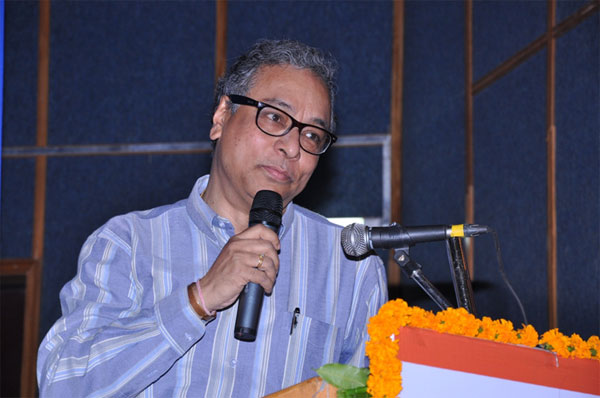
Shri Sircar expressed the opinion that almost all ancient religious texts also served the purpose of legislative and prescriptive structures in the pre-legislative period and therefore caution needs to be exercised while dealing with their contents. In the 21st century when we are emerging as a big economic power in the world, India may not necessarily need proof of the antiquity of its civilization. Let us not forget that antiquity has a lot of respectability attached to it! He wanted a compilation of all the presentations made during the seminar expressing a keen desire to read them all.
Address by Shri Manbir Singh, IFS, Secretary (ER), Ministry of External Affairs, Govt. of India as Guest of Honour on 31st July, 2011
Shri Manbir Singh expressed the view that with the presentations made during the Seminar, the haze caused by time and history seems to be receding and the events of our ancient past seem to be unfolding and crystallizing right in front of us. It is the beginning of a new initiative and the road ahead appears to be very exciting as it pushes back the antiquity of our civilization!
Shri Singh took note of the fact that this Seminar is not only about the theoretical aspects of scientific dating of ancient events but also talks of the business opportunities being thrown open by this kind of research. It talks of the practical applications of the research outcomes in food production, water resource management, reinventing medicines for the treatment of several diseases, promotion of tourism to cover the ancient sites covered by the research project of I-SERVE, addressing environmental issues, etc. He emphasized that while the Seminar has attempted to know the truth and historicity behind our beliefs, beliefs remain most important; these are rooted in antiquity and they give us our civilization, heritage and value systems. Science is important but these beliefs are probably above science and they represent the truth we have all believed in through the ages.
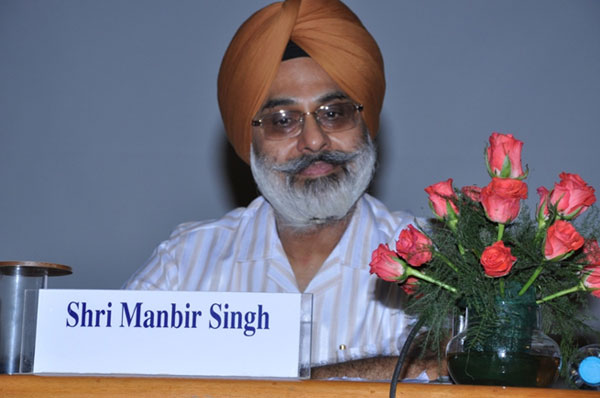
Address by Smt. Poonam Kishore Saxena, Member, Central Board of Direct Taxes (CBDT) on 31st July 2011
Smt. Poonam Kishore Saxena was of the opinion that the topic of the Seminar was such that it would immediately spark curiosity in the listeners. We are normally aware of our ancient manuscripts and we often learn about the individual scientific studies being conducted by archaeologists, astronomers, geologists, oceanographers etc. in their individual fields, but no one has so far attempted to analyse and correlate these studies for determining the historicity of ancient events narrated in our ancient texts.
She appreciated the Institute of Scientific Research on Vedas (I-SERVE) for carrying out intensive research to connect all the credible evidence from varied scientific fields to prove the historicity and dating of the ancient event. The astronomical dating of planetary references in ancient manuscripts and the co-relation seen of these dates with archaeological, geological, anthropological, oceanographic, ecological and remote sensing evidence is the most path-breaking finding in research that could be done by anyone. This is the first initiative of its kind and the Seminar has succeeded in bringing the idea to the fore that a combination of various scientific studies can provide credible scientific evidence that not only the Indian Sub continent's Civilization is of great antiquity but also that it was greatly advanced and perhaps Indigenous. The events narrated in our ancient scriptures were not imaginary or just myths but truly happened and rolled out in the manner depicted.
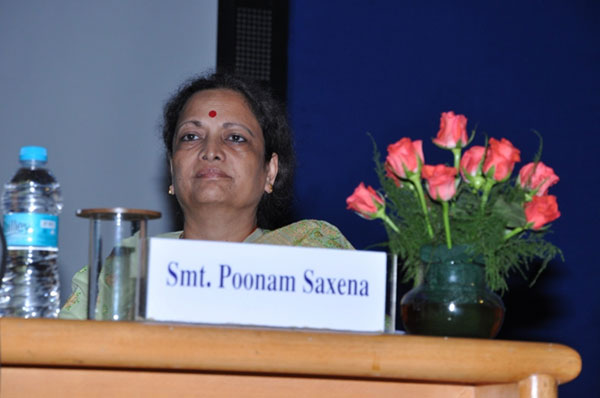
Research has rejected the Aryan Invasion Theory & has proved the indigenous origin of civilization in India; said Dr Kalam during his Inaugural Address (Part -3)
Dr kalam said that senior scientists and researchers from different disciplines of science have proved that there are no scientific proofs of any Aryan invasion in India. On the other hand, multi-disciplinary scientific research has proved that indigenous civilization has been developing in India since the Rigvedic Era for more than 9000 years. Hear him saying, “I am happy that through such genomic studies, it has been found that Harappan civilization was not of mysterious people of unknown biological origins, or migrants from centres of high culture in western Asia, but they were descendants of a population identified with pre-Harappan cultures of the North Western sector of the sub-continent.
For more information and videos on the subject visit -
https://www.youtube.com/c/RigvedatoRobotics/videos
This makes research in genetic engineering, using human genome sequences to understand the evolution of humans, very fascinating for scientists…... I am happy that through the use of modern technology, the perception of Indian Archaeology has changed and has facilitated the researchers to prove an indigenous origin of civilization in the Indian Sub-continent.
This is an important factor that should work as an integrator of the entire nation since all of us have come into this land from the same ancestors and roots. The research on scientific dating may have partners, who can provide scientific, astronomical, anthropological and geological and genetic data to ascertain the veracity of the historical events.
After this Inaugural address, scientists from different disciplines made presentations, the PDFs of which our us under -
Summary of the Proceedings of the National Seminar by Mrs Saroj Bala, Research Project Co-ordinator
She read out an extract from Dr Kalam's inaugural address on 30th July 2011; he has rejected the Aryan invasion theory and has made a strong case for rewriting the history of the Indian sub-continent, based purely on multi-disciplinary scientific research. He said, “I am happy that through such genomic studies, it has been found that Harappan civilization was not of mysterious people of unknown biological origins, or migrants from centres of high culture in western Asia, but they were descendants of a population identified with pre-Harappan cultures of the North Western sector of the sub-continent.
This makes research in genetic engineering, using human genome sequences to understand the evolution of humans, very fascinating for scientists…... I am happy that through the use of modern technology, the perception of Indian Archaeology has changed and has facilitated the researchers to prove an indigenous origin of civilization in the Indian Sub-continent. This is an important factor that should work as an integrator of the entire nation since all of us have come into this land from the same ancestors and roots.”
Researchers through their presentations have proved the indigenous origin of civilization in India
She added that the presentations made by scientists from at least eight disciplines of science during the Seminar have not only proved the indigenous origin of the civilization and culture in India but have determined the precise dates of events narrated in Rigveda and Ramayan. These have proved that during the Holocene for the last 10000 years, there has been constant indigenous development of Vedic Civilization in Bharat Varsha. Aryan Invasion theory was nothing more than a figment of imagination and repeated thousands of times. Its perpetrators only proved Hitler correct that if a lie is told a hundred times, it gets accepted as the truth. I-SERVE announced that the research would continue, more seminars and conferences would obviously be organised and the entire ancient history of Bharat Varsh would be reconstructed scientifically, which would create a shared pride in our heritage.
Smt. Saroj Bala explained that this National Seminar also proposed to bridge the gap between the information contained in research reports of our eminent modern scientists, available with the Ministry of Science & Technology and Earth Sciences on one hand and the contents of our School and college books on the other. The history has to be looked at as the history of events that occurred sequentially on our land during the last thousands of years. This only can lead to shared national pride amongst all Indians in our ancient most cultural heritage and scientific achievements of dim distant past -
- The astronomical dates of planetary references in ancient books calculated by eminent astronomers by making use of planetarium software, indicate the development of an indigenous civilization in India from dates even before 7000 BC. Astronomical references in Rigveda represent the sky view of dates belonging to the period from 7000 BC to 5500 BC and those mentioned in Ramayan refer to sky views seen sequentially on dates around 5000 BC. These dates are exclusive and match sequentially.
- Remote Sensing pictures taken by ISRO, corroborated by geological reports, have revealed that a mighty river system, referred to in Vedas and Epics as Saraswati, was flowing with full majesty around 6000 BC. The river slowly dried up and almost disappeared around 3000 BC. These conclusions have been supported by sedimentology, hydrogeology and drilling data. These conclusions not only support the astronomical dates of Vedas and Epics but also support such references in ancient books.
- The palaeobotanical research reports have revealed that certain cultivated varieties of plants, trees and herbs, which are mentioned in Vedas and Epics, have existed in India continuously for more than 8000-10000 years. Remains of cultivated rice, wheat and barley have been found belonging to 7000 BC; melon seeds, lemon leaf, pomegranate, coconut and date palm, etc. relating to 4000 BC; lentils, millets and peas etc from 3000 BC; use of reetha, amla and shikakai for making shampoo since 2500 BC. These plants remained in use continuously indicating that there was not any abrupt end of ancient Indian civilisation as is normally being taught in schools and colleges.
- The latest archaeological excavations have revealed a large volume of new data that has proved the indigenous origin and development of civilization in the Indian Subcontinent since 7000 BC. Some examples are Lahuradeva, Jhusi, Tokwa and Hetapatti in Ganga Valley in the east; Mehrgarh, Kot Diji and Nausharo in Indus valley in the northwest; Lothal and Dholavira in the west. The material testimonies of these excavations have shown gradual cultural developments from the 7th-6th millennium BC in the entire region of the Indus-Saraswati-Ganga system for a period of almost eight thousand years.
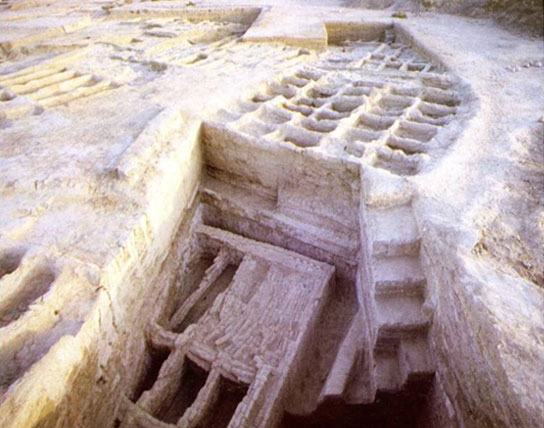
Superimposed compartmented buildings used for storage from 6000 BC, Mehrgarh (Jarrige 2007-08)
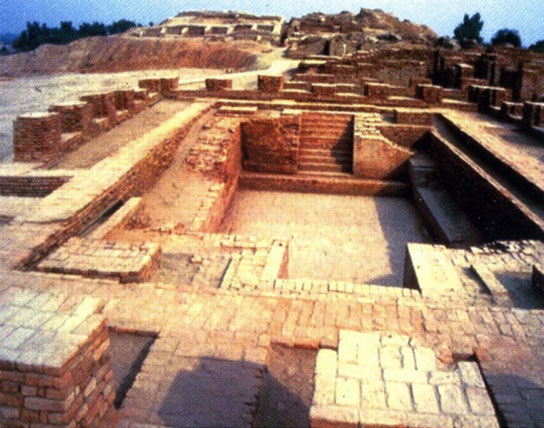
Great bath, 2500 BC Mohenjodaro (after Agrawal 2007)
- The anthropological research reports have established that DNA dating for Palaeolithic continuity starts from 60,000 BC. The Genome studies during the Holocene have revealed that the genetic profile of humans settled in north, south, east and west of India is the same and has remained the same for the last more than 11000 years. It is also significant to note that the inhabitants of the Harappan civilization were not a mysterious people of unknown biological origins or migrants from western/central Asia, but they were the indigenous people identified with the pre/early Harappan cultures of the northwestern region of the Indian subcontinent. Therefore, contrary to popular belief, the Dravidians as well as north Indians have common ancestors and both are originals of India, have a common genetic profile and thus had common ancestors.
Recommendations for follow-up action:
Based on presentations made during the seminar, some very valuable recommendations were made for taking certain steps/ follow-up action by the Government departments, universities and autonomous bodies like the National Institute of Oceanography and Archaeological Survey of India, as under:
- The invention of new scientific tools and methods over the last 30-40 years has made scientific dating of ancient events very much possible, thus making the reliance on linguistic guesswork and religious beliefs unnecessary. History should no longer be a subject belonging to the Faculty of Social Sciences or of Arts, rather it needs to be made an integral part of the Faculty of Sciences and placed as a multi-disciplinary science subject by the Universities of the world.
- Such scientific dating can transform ancient India's events mentioned in Vedas and Epics from the realm of mythology to that of history, creating a shared pride amongst all Indians in our rich and most ancient cultural heritage. The historicity of Epics like Iliad and Odyssey would also probably get established. This in turn will facilitate the creation of a more peaceful and united world by removing artificial and false divisions which got created amongst the communities of the world, particularly in India, on account of linguistic guesswork and lack of scientific knowledge.
- Ancient Sanskrit books contain a rich wealth of knowledge of ancient sciences and of historical events that occurred in the remote ancient past. The presentations indicated a close correlation between the astronomical dating of ancient events and fluctuations in water volumes of ancient rivers and oceans. Such fluctuations in water volumes in ancient books got almost fully corroborated by the fluctuations in the sea level curve prepared by NIO for India's West Coast. There is a need for more exploration at greater depth both along the east coast and west coast by NIO, Goa.
- Rashtriya Sanskrit Sansthan was requested to modify its policy regarding the allocation of subjects to PhD students so that they take up topics like extraction of planetary references from Vedas and Epics, extracting references to glaciers & fluctuation of water volumes in rivers and oceans, reconstructing genealogies from Puranas and Epics, etc. These could be made available to the other scientists along with Hind/ English translations.
- Universities were requested to make modifications to their policy relating to Research and PhD so that two to four research scholars could take up multidisciplinary research with Guides from different departments and a coordinator. This can lead to a major initiative in scientific dating of ancient events referred to not only ancient books of India but of the whole world.
- The Ancient History of India, being taught in schools and colleges so far is generally based on linguistic guesswork and religious beliefs/hearsay. There is an urgent need to unearth the evidence of ancient events buried under land and sea through multi-disciplinary scientific research, which should include astronomical dating of planetary references in ancient books by making use of planetarium software.
- The Indian Council of Historical Research deserves to be reconstituted by the Ministry of HRD so as to include Sanskrit scholars, Astronomers, Geologists, Oceanographers, space scientists, palaeobotanists and Ecologists so that ancient Indian history is rewritten purely on an objective and scientific basis. These disciplines were not represented in the past.
- Considering that the latest scientific tools and researches have proved that Vedas and Epics of India refer to several events, the historicity of which is scientifically verifiable; there is a need to carry this research to its logical conclusion by launching at least 100 PhDs on the subject by accepting the recommendation of His Excellency Dr A.P.J. Abdul Kalam.
- The presentations made during the Seminar be used to promote tourism in a big way by taking some initiatives which could include: (i) setting up an underground museum on the site of submerged Dwarka connected through a transparent tube, (ii) package tours to cover places excavated around ancient Saraswati River, and (iii) trips to important places visited by Lord Ram still having similar physical features, flora and fauna as well as ancient memorials.
- Remote Sensing images read with literary references, geological and archaeological research reports have revealed a vast network of palaeo-channels of rivers, including that of the Saraswati River system. The Ministry of Water Resources may constitute a multi-disciplinary team to identify and harness the drinkable water trapped under the dry beds of these rivers to solve the water scarcity problems of our countrymen in these areas.
- The genome studies presented during the seminar have revealed that humans settled in all parts of India, including North Indians, Dravidians and tribals, share their genetic profile and had common ancestors since 11000 BP (9000 BC), rather than since 55000 BP (53000 BC). This fact should be widely publicized by the Ministry of Culture so that the north-south divide, which was created due to the Aryan invasion theory that has now been proved to be untrue, is removed and all Indians have the opportunity to share common pride in having common ancestors.
- In the interest of historical and medical research, the Ministry of Culture is requested to direct the Anthropological Survey of India and Anthropology departments of Universities to carry out Genome/DNA studies of the people of the Indian subcontinent over the last 12000 – 15000 years. This will facilitate the development of a DNA-based medicine system for diseases that have been prevailing in certain areas for thousands of years. Correlation of such Genome studies with the genealogies of ancient rulers and of other classes be ascertained scientifically, which is likely to prove as a great unifying factor for different communities and classes in India.
- The presentations made revealed that 99% of Indians do not know about 99% of the existing scientific research reports that prove the historicity and antiquity of India's ancient civilization, apparently because such reports are not being regularly passed on by the ministries of Earth Sciences, Culture, Science & Technology and Water Resources to Ministry of HRD. It was suggested that a system be put in place to incorporate such research outcomes in books meant for schools and colleges all over India.
- To create and develop mechanisms for disseminating the outcomes of such multidisciplinary research reports in every nook and corner of India so that people from all casts, colours, creeds and backgrounds become aware that they are originals of India, had common ancestors and have inherited a very rich and most ancient civilization.
